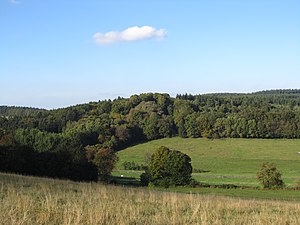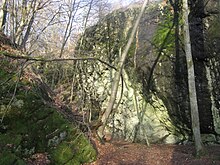Beilstein (Hessian Spessart)
| Beilstein | ||
|---|---|---|
|
General view from the southwest |
||
| height | 499.5 m above sea level NHN | |
| location | Hessen , Germany | |
| Mountains | Spessart | |
| Dominance | 1.1 km → High mountain | |
| Coordinates | 50 ° 10 ′ 13 ″ N , 9 ° 24 ′ 10 ″ E | |
|
|
||
| rock | basalt | |
| Age of the rock | 10 to 20 million years | |
| particularities | Remains of the small hilltop castle Beilstein | |
The Beilstein is 499.5 m above sea level. NHN high mountain in the Spessart . It lies east of the road from Bad Orb into the Jossatal between Villbach and Lettgenbrunn in the area of the municipality of Jossgrund .
geology
The Beilstein is a basalt cone with the largest basalt cave in the Main-Kinzig district . The formation was formed by volcanic eruptions 10 to 20 million years ago; the surrounding red sandstone , which otherwise characterizes the Spessart, is around 200 million years older. The basalt breakthrough was exposed by erosion; You can see the typical basalt columns and smaller, spherical structures on the rock walls.
history
The remains of the small, high-medieval hill castle Beilstein are located on the mountain, which was first mentioned in a document in 1059 . It was built to protect the property of the Archbishopric of Mainz and to control an old road, and was first mentioned in 1343. It was also intended to protect the first glassworks that were built. When the rule passed to the Counts of Hanau , the castle probably lost its importance and has since fallen into disrepair. Due to the poor sources, little is known about the castle. Today the facility consists only of a wall ring about 12 meters long.
The 40 meter high basalt dome was designated as a natural monument as early as 1905 . Nevertheless, the basalt was initially mined further. This changed in 1930 when the oldest nature reserve in what was then the Gelnhausen district was established on the Beilstein .
Until 1913 there was a forester's house at the foot of the Beilstein, which was demolished when the imperial training area was being created. There was a second interruption in nature conservation in the National Socialist era after 1935, when Lettgenbrunn / Villbach was declared a bomb-dropping training area for the Gelnhausen-Rothenbergen air base and cleared. An observation bunker was built on the Beilstein, which was blown up after the war.
A new protection under the Federal Nature Conservation Act took place in 1977. Hiking trails around the basalt knoll were provided with information boards. The Beilstein is also a station on the "European Cultural Cycle Route Pearls of the Jossa", an approx. 25 km long cycle route through the Jossgrund, which was created to promote tourism in the Spessart.
Say of the miracle flower
Around the Beilstein there is a legend of a young man with a freshly picked blue miracle flower that he had put on his walking stick; then on the Beilstein the gate to the otherwise locked rock castle opens for him, and the man is led inside by three beautiful women. He fills his pockets with gold, silver and precious stones, but the women warn in vain: "Don't forget the best". Suddenly there is a rumble of thunder and the walls of the mountain castle collapse. The man runs for his life and just escapes through the closing gate, losing all the treasures he has picked up. He is punished for forgetting "the best": the walking stick with the blue wonder flower, which he carelessly put aside.
The too great greed has blocked the young man's view of the essentials. Local researchers have linked the blue wonder flower with the pitch rose .
Nature reserve
The Beilstein nature reserve and FFH area refers not only to the basalt dome, but also to the surrounding forests; Moss-covered old wood and dead wood is left to its own devices. About 200 plant species are documented on an area of 5.75 hectares.
Between the spruce trees there are islands of beech forests mixed with summer linden and maple; the mountain elm has its only place on the Beilstein in the Spessart.
The large basalt cave serves as a wintering place for various bat species . The heat-storing basalt on the hard-to-reach rocks is ideal for endangered plants such as pitch rose, rue , grass lily , Turkish lily and potted fern . The rare Heidewicke has not been seen since 1975; Also Carthusian Elke and winged Orchid disappeared.
About one kilometer to the north is the crater of the Hohe Berg , which is recognizable from the previous quarry activity .
Web links
- The legend of the miracle flower on Project Gutenberg-DE: Legends from Bavaria - the Beilstein
Individual evidence
- ↑ Map services of the Federal Agency for Nature Conservation ( information )
- ↑ Rudolf Knappe: Medieval castles in Hesse: 800 castles, castle ruins and castle sites. 3. Edition. Wartberg publishing house. Gudensberg-Gleichen 2000. ISBN 3-86134-228-6 , p. 380.
- ^ Ordinance on the "Beilstein" nature reserve of February 11, 1977 . In: Higher nature conservation authority (ed.): State gazette for the state of Hesse. 1977 No. 10 , p. 584 , item 384 ( online at the information system of the Hessian state parliament [PDF; 6.6 MB ]).






